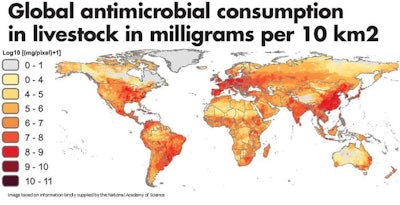
This article appears in the August issue of Poultry International. View all of the articles in the digital edition of this magazine.
The risk of disease in poultry production is ever present, but as livestock producers face growing pressure to eliminate preventive use of antibiotics, and reduce use as treatments, new and complex challenges have emerged.
There are, however, numerous strategies that can be followed to minimize disease risk and ensure birds are better able to resist infection. These, along with emerging strategies to better target when and where treatment may be needed, came under the microscope at the Poultry Summit Europe 2016, held in Utrecht, The Netherlands, in mid-May.
Antibiotic-free poultry
Antibiotic free production in many developed markets is no longer simply an option but a growing necessity and, according to Willem van de Oetelaar, HatchTech hatchery coaching manager, steps can be taken right from the start of a chick’s life to minimize possible future need for antibiotics.
It is important to get back to basics, he believes. Stress, and its impact on triggering subclinical diseases, is far too often underestimated, but if the stresses of thirst and hunger can be removed during a chick's first days of life, and the chick given only a gradual introduction to light and minimal handling, then stress will be minimized and the chick given the best possible start in life.
Giving chicks the best start was echoed by Adrian Smulders, species technology manager and additives lead with Cargill Premix and Nutrition EMEA, highlighting the importance of early feeding.
Increasing attention is being paid to gut health, and it is during the first few days of life that the chick’s intestinal tract is formed. Correct early feeding is essential if the intestinal tract is to be optimally formed, and so better able to resist any disease challenges in later life, Smulders said.
Good biosecurity
Assuming that chicks have been given the best possible start in life, that investment needs to be protected.
Professor Jeroen Dewulf, of the faculty of veterinary medicine at Ghent University, raised the importance of good internal and external biosecurity, as strong biosecurity will result in less disease.
There is, however, little hard data on what actually constitutes good biosecurity and producers too often put an emphasis on reducing small risks, failing to address the more important challenges.
To this end, the university has developed a simple and free-to-use biosecurity scoring system for pig and poultry producers. External biosecurity accounts for 70 percent of the total score in broiler production, while internal biosecurity – comprising disease management, cleaning and disinfection, and materials and distance between houses – accounts for the remainder.
The system offers a simple pass/fail result. Dewulf notes that, on some farms that have taken the test and subsequently engaged in counselling to improve biosecurity and reduce antibiotic use, antibiotic treatment days have declined by 29 percent.
Keeping birds healthy
Disease threats, and the consequent need to treat, can come from a variety of sources, including feed, litter, air and water. What is key is to minimize those threats and keep birds in the best possible condition to reduce susceptibility.
Damaged lungs due to a buildup of ammonia in the poultry house, for example, will be more susceptible to infection, so even good ventilation can play its part in reducing the need for antibiotic treatments.
Gut health
Professor Leo den Hartog of Wageningen University looked to nutritional strategies and the gut to aid in the responsible use of antibiotics.
Managing intestinal health can be achieved through preventing intake of harmful bacteria, managing the microbiota, improving the intestinal barrier, and immunomodulation.
There are three pillars for antibiotic reduction at farm level, he argues:
- Good farming management and hygiene practices
- Targeting only affected animals for treatment
- Adequate nutrition and gut health
Good nutrition is the foundation for gut health, but functional feed additives can support animal health and growth while reducing the risk of disease.
Antibiotics should be used when needed, he believes, but improving and stabilizing the gut microbial balance can mean that there may no longer a need for antibiotics to control gut health.
Importance of welfare
Professor of Animal Behavior Marian Dawkins of Oxford University looked at how animal welfare and disease are connected, noting that good welfare leads to lower mortality, lower injury and disease levels, and reduced risk to humans.
However, welfare is too often evaluated at the end of the production cycle, and she and her team have been trying to look much earlier by using optical flow technology.
Measuring flock behavior has revealed that flocks with poor welfare move more slowly, while flocks with higher welfare move more quickly. The technology can used to measure which flocks will have a higher incidence of hock burns, for instance.

Optical flow is among technologies being examined to determine the emergence of disease earlier in poultry production, so permitting more targeted treatments.
The Oxford team has been looking at several important production diseases, including Campylobacter infection, and optical flow has been able to distinguish positive from negative flocks.
Indications of infection emerge very early on, she explained, and such early detection means treatments can be much more targeted.
The poultry industry produces huge amounts of data, but where there are no common parameters, interpretation and comparison becomes difficult.
Bouke Hamminga, director of international sales and business development with Pas Reform, argues that any data needs to be handled with care, including where antibiotic usage is concerned.
Despite the poultry industry already having a gold mine of production data, much is still not analyzed and, like Dawkins, he believes there is a strong link between poultry welfare and immunity.
Antibiotic resistance not solved by livestock curbs alone


















